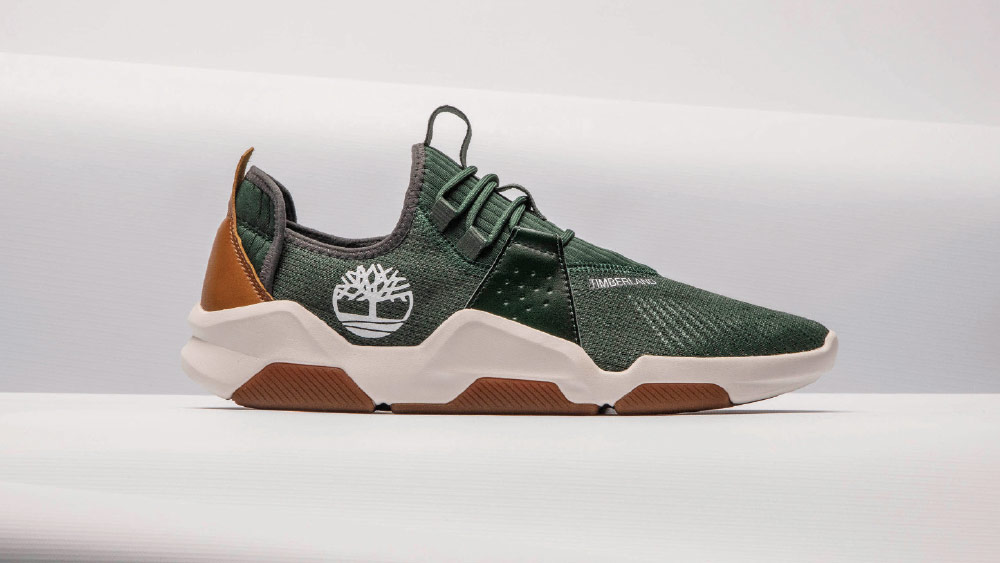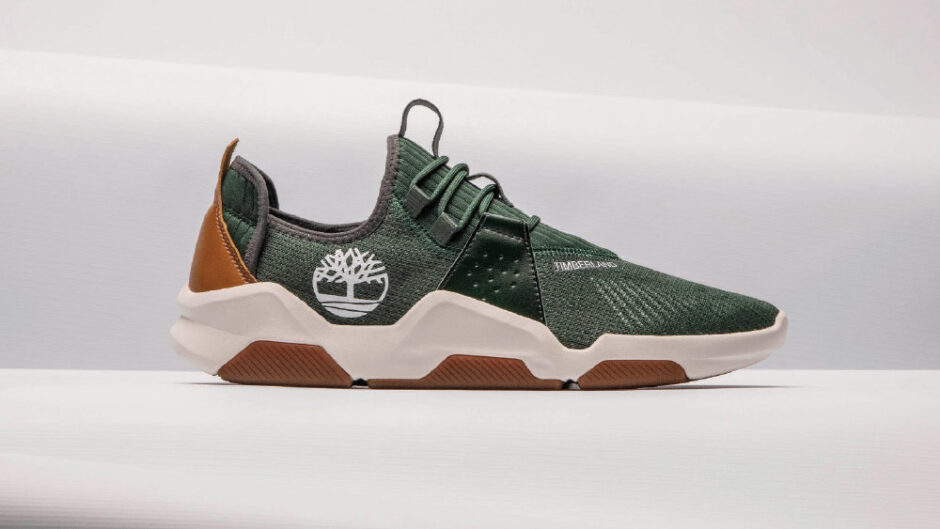
When it comes to sustainable business practices, Timberland is OG: original green. Its efforts date back to the early ’90s when the brand began trailblazing a path of eco-friendly best practices—at a time when “being green” was more associated with Kermit the Frog than corporate America. Sustainability wasn’t the fast-growing field it is today. Back then, brand efforts were often slowed by such headwinds as bogus green claims that confused and turned off consumers, and shoes that cost more, looked worse and didn’t last as long as their non-green counterparts. But Timberland pressed forward, convinced that making meaningful improvements—wherever, however and whenever it could—was not only the right thing to do, but also good for business.
For the past 14 years, Colleen Vien has been at the forefront of Timberland’s green and good efforts. She joined the company’s corporate social responsibility (CSR) department as a factory auditor, monitoring code of conduct in its North American factories and, over time, globally. Matters like human rights, worker well-being and community impact were her areas of expertise. About five years ago, Vien took on a broader role in the company’s sustainability program, overseeing product development, stewardship and environmental footprint. For her, it’s a dream job. “I pinch myself often in how fortunate I am,” Vien says. “It’s fun to be fighting the good fight.” Of course, the job has its share of frustrations. “I always tell people looking to get into the sustainability field that you’d better have the three Ps: patience, pleasantry and persistence,” she says. “There are always ROI concerns, problems that you must solve for (sometimes repeatedly) and people who just say no. It’s fun, but it’s no cake walk.”
Here, Vien discusses why she believes the current swell in sustainable fashion is at a “tipping point” and how Timberland is pushing the envelope to make eco-friendly goods as good for the planet as they are good looking and well made.
Is green the new black—again? I don’t think it’s again. I think green is the new black for the first time. While sustainability, CSR and product stewardship have been buzz words that have ebbed and flowed over the years, I believe we’re at a tipping point now that the fashion industry is in the game now. Sustainably made fashion has become something desired by consumers, making green that new black.
Why might this movement have legs this time? For a variety of reasons. Transparency and availability of information has led to increased consumer awareness. The level of holding companies accountable is stronger than ever. Innovation is another reason. Look at the sustainability options available today, whether it’s the material choices or renewable energy options. It’s an exponential change over the past 10 years and a huge driver for why this movement has legs now. Along with that is the supply and demand factor: more people demanding and more manufacturers supplying sustainable goods means the costs have leveled where many of the recycled, organic or renewable options that we put into our products are not just cost parity, but a cost savings.
The bar on eco-friendly style has been raised. Right. Take our relationship with Christopher Rayburn (named Timberland’s Global Creative Director last fall). He comes from a fashion background of making sustainable products cool on the runways. That’s an opportunity that didn’t exist even five years ago. He talks about how Timberland inspired him when he came out of design school when we launched (eco-friendly) Earthkeepers in 2007. It’s fun to have it come full circle and him our partner now.

Lots of brands are introducing sustainable designs of varying degrees and possible confusion. How will Timberland convey that its efforts are authentic? It has to be done in layers and different modes of media. At a high level, our messaging will be simple and succinct. We’re not going to get into specific details regarding the sustainability of our products there. Our campaign this fall is Nature Needs Heroes. It’s a call to action that nature needs us and here are ways you can get involved with Timberland. As consumers dig through layers, that’s where on social media, for example, we’ll talk more about a shoe’s sustainable materials. There will also be changes to our website in terms of how we draw consumers in and explain that our tree logo stands for nature and that everything we design is something that you can be proud of from a sustainability perspective. It’s not just a seasonal campaign, and it’s not just one product.
The sustainability theme marks a shift in marketing philosophy, correct? We’ve always been humble and didn’t think we needed to tout to the world the green and good we were doing because it was the right thing to do for the planet and people. But continuing to do that might put us at a disadvantage with so many brands boldly jumping onto the green bandwagon. For many in the mainstream, this will be the first time they’ve heard about our sustainability efforts. We need to stand tall and show that our efforts are authentic and transparent in what we do, how we do it, and the lengths and the duration that we have been doing it for. We aren’t just a flash in the pan. When it comes to our green and good initiatives, we’ve been at this for 26 years, if not more.
What are some noteworthy sustainability initiatives for Spring ’20? One of our goals for 2020 is to have 100 percent of our footwear in market contain major components that are made of either recycled, organic or renewable materials. In 2018, that figure was only 69 percent. That’s a considerable amount of work to get to our goal, but there is a full commitment from the management and product development teams to get there. All our new SKUs that we’ve developed over the last three to five years feature recycled, organic or renewable materials. It’s the carryover styles that were in the market before we had these product standards that require reengineering to meet those standards. Another exciting platform is ReBotl, our polyester material made from recycled plastic bottles. We’re looking to use it in a much bigger way across our product line starting in Spring ’20.
Is the Holy Grail 100-percent renewable materials and a zero carbon footprint? Anything is possible, and Timberland is a brand that likes to say don’t tell us it can’t be done. I think there are several different types of holy grails. A world where plastic doesn’t exist is a holy grail. The role that Timberland can play overall is not just maintaining current sustainability levels, but finding ways to bring even more positive impact onto the planet. Like with leather. To date, the industry hasn’t considered itself responsible for the environmental impact of cattle ranching. But studies show the biggest impact occurs during grazing and not necessarily the tanning process. We can no longer be an industry that turns a blind eye to how cattle are raised. We’re working hard to influence the cattle ranching industry in the United States because over 95 percent of our leather is sourced here.
Exactly how will Timberland make an impact here? By working with ranches that practice regenerative agriculture, which act like carbon sinks. It’s one of the top ways to reverse climate change. It’s so exciting, and we want the entire industry behind it once we prove that it can be done effectively. We first had to solve for a traceable supply chain, so we know that the hides we’re purchasing come from ranches practicing this type of agriculture. We achieved that, and we’re excited that Fall ’20 collection will feature products certified from such ranches.
Cow farts have become headline news. Cattle are the new SUVs. I love the documentary Soil Carbon Cowboys. One of the scientists involved in the film is partners with us on this project. Regenerative agriculture is a growing topic of interest. Just like circularity used to be a topic at sustainability conferences and then became a conference unto itself, regenerative agriculture has grown like that over the last six months.
Any drawbacks to being too green a brand? There shouldn’t be any drawbacks for Timberland because we’re a brand that looks to operate our business in an authentic and responsible way across the board. We’re trying to make ethical, responsible decisions at every touch point. We’re also very transparent about this. We might even be the first radical to call ourselves out on something. Our CSR reporting shows we’re not perfect. We disclose the challenges we’re facing and when we’re not hitting our goals. It’s like a call to action to help us solve for it. Anything that could have been solved for, we’ve done. That said, there’s a need for balance in our messaging and conversations with consumers, because we only have a split second to grab their attention and not overwhelm them. That’s a fine line, and I think our marketing team does a great job walking it—getting consumers to understand and be appreciative of the issues that we’re so passionate about so that they join us on the journey.
How do you stay optimistic in the face of doomsayers saying the planet is a lost cause? I’m fortunate to work for a brand that believes in the power of business to make a positive impact on the world. I also have privy to a lot of the good things that not just Timberland but other industries are doing. That gives me more optimism. But the media needs to do a better job at telling positive stories, because I do think people are tired of hearing the world is crap. We need to inject more positive energy into the movement of change.
Like Timberland doubling its green footprint in five U.S. cities? Yes, that’s part of how we want to engage with consumers more. We’ve held large-scale tree planting initiatives around the world for years and have planted over 10 million trees. But the plantings were in Haiti, Dominican Republic and Inner Mongolia. We decided to bring that effort closer to home, and have more than doubled our footprint in five major markets here. Over the past year, we’ve held events in New York, Philadelphia, Los Angeles, Chicago and Detroit. The beauty is we’re not just telling our consumers the good that we’re doing, we’re inviting them to do that with us. It’s very exciting.




